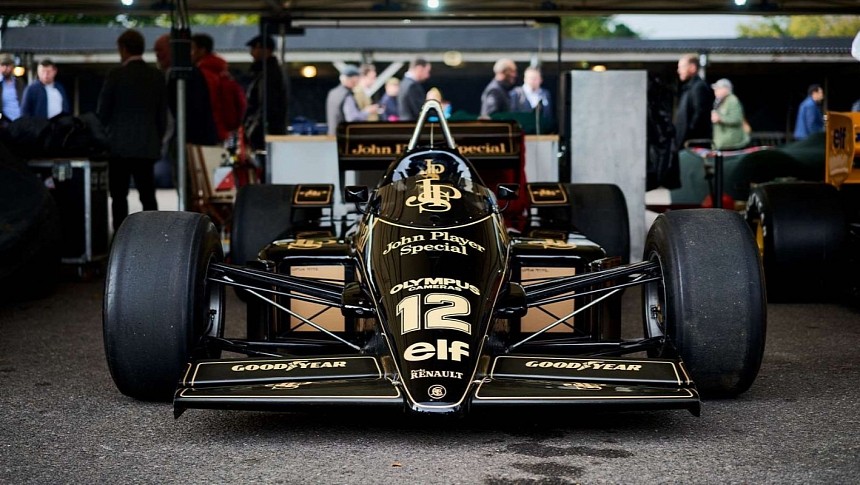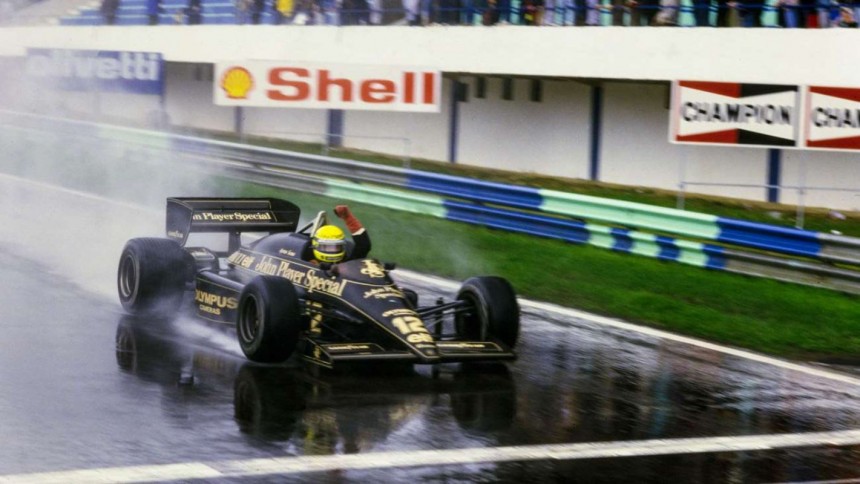Step right up, ladies and gentlemen, and feast your eyes on the stunning 97T! This sleek machine, designed by none other than the legendary Gerard Ducarouge, marked a triumphant return to the winner's circle for Lotus after the tragic passing of its founder.
Colin Chapman was no ordinary man. A visionary engineer, a wheeler-dealer, and a pusher – he was the driving force behind Lotus, extracting brilliance from his team and defining the organization in all its magnificent, yet often fragile, glory. His passing in 1982 should have marked the end of an era, but Chapman's legacy lives on, and the 97T stands as a testament to his unwavering passion and dedication.
In rode Peter Warr, the knight in shining armor and long-time Team Lotus manager who had recently returned from a stint at Wolf. Practical and level-headed, Warr had always served as a counterbalance to Chapman's impulsive nature, and his steady hand guided the team through the tumultuous aftermath of Chapman's passing. One of his shrewdest moves was bringing on board the talented engineer Gerard Ducarouge, who had previously worked with Matra and Ligier before a stint with Alfa Romeo's works team ended in disappointment.
But Ducarouge was no ordinary designer. He didn't spend his days hunched over a drawing board with a pencil in hand – instead, he brought contagious energy and galvanized the entire design team. They had been used to working under Chapman's watchful eye for years, but with his passing, they were adrift. It was Ducarouge who stepped up to the plate, appraising the team's lackluster 1983 cars – the Cosworth-powered 92 and the Renault turbocharged 93T – and initiating a complete redesign based on the tub and suspension of the previous year's cars. With Ducarouge at the helm, Team Lotus was once again poised for greatness.
In a feat of engineering black magic, the 94T roared onto the scene just five weeks after its conception, ready to make its debut at the prestigious British Grand Prix. Elio de Angelis, one of Lotus's star drivers, qualified an impressive fourth, only to be foiled by a slow start and a pesky piston that had decided to go on an adventure. But the team's fortunes weren't all lost – Nigel Mansell, starting from a lowly 18th on the grid, fought his way up to fourth place, marking the team's best result since de Angelis's nail-biting victory at the 1982 Austrian GP.
The following season, Lotus made a fateful decision to switch to Goodyear tires, a choice that would ultimately prove to be their downfall. The McLaren team, equipped with Michelin tires, proved to be faster over race distances than Lotus's new 95T. And while the TAG-Porsche engine might not have matched Renault in terms of pure power, it more than made up for it with its reliability and fuel efficiency. A ban on in-race refueling and a maximum fuel tank size of 220 liters also put a cap on the team's performance, punishing their thirst for speed. De Angelis was lucky to even finish in third place at the San Marino Grand Prix when his 95T ran out of fuel on the final lap.
Peter Warr, the shrewd team manager, wasn't entirely satisfied with his two drivers. Despite his suave demeanor and aristocratic background, Elio de Angelis lacked the relentless drive necessary for true greatness in the sport. Nigel Mansell, on the other hand, simply couldn't cut it at the highest level, a fact that was underscored by his costly blunder at the Monaco Grand Prix.
But Warr wasn't one to dwell on the past. The team soldiered on, making crucial aerodynamic tweaks and upgrading to superior Goodyear tires in the following year. Gerard Ducarouge, the brilliant engineer behind Lotus's resurgence, worked tirelessly to evolve the 95T into the 97T, incorporating some innovative ideas from a failed Indycar project. The resulting car boasted several groundbreaking features, including bargeboards situated between the nose and rear wheels and a clever workaround to new regulations banning lateral extensions on the rear wing. Rather than abandoning the idea altogether, Lotus simply relocated them to the side pods ahead of the rear wheels.
The Lotus F1 team was on the move. Ayrton Senna, a Formula 3 superstar, had been on Peter Warr's radar for the 1984 season. Despite agreeing to a bargain $50,000 contract, sponsor Player's blocked the deal, opting for Nigel Mansell instead. However, Warr eventually got his man, but with Senna's incredible maiden season with Toleman, his asking price had skyrocketed to $585,000.
The 97T retained the nimbleness and agility of the previous car, with a pull rod-actuated suspension front and rear. This car would be the last Lotus F1 assembled with a hybrid approach, utilizing flat carbon and kevlar sheets sandwiching an aluminum honeycomb reinforcement structure that was folded, cut, and bonded together.
The new Renault EF15 engine was a powerhouse, generating approximately 1200bhp in qualifying trim with large Garrett turbochargers paired with a low-compression configuration of the 1.5-liter V6. Lotus would fit higher-compression engines with smaller turbos for races, improving fuel economy and reducing power lag. Future Lotuses would embrace moldings, as pioneered by McLaren, but this car remained faithful to the traditional monocoque structure.
The 1985 Formula One season began with high hopes for Lotus as their drivers, De Angelis and Senna, showed strong form in practice and qualifying for the Brazilian Grand Prix. However, last-minute efforts from Alboreto and Rosberg relegated them to the second row on the grid. On race day, Senna was on track for a podium finish in the punishing heat before his ignition system failed.
At the next race in Estoril, Senna secured his first pole position, outpacing his teammate and even the previous race winner, Prost. However, heavy rain on race day stirred up anxiety in the Lotus garage, as they remembered Mansell's crash in similar conditions at Monaco the previous year. Despite Senna's impressive performance in that race, nerves remained high as he had never driven the 97T in the wet, and his car had required mechanical attention.
However, Senna defied expectations and launched smoothly into the lead, with De Angelis close behind. Even the best drivers on the grid struggled in the rain, but Senna's progress was imperious. By lap 20, he had built up a 30-second lead over De Angelis. Despite calls to stop the race due to worsening conditions, it was allowed to continue until the two-hour cut-off, by which time Senna had lapped everyone except Alboreto, who had taken second place.
Lotus was a team on the rise after a difficult period following the death of its founder, Colin Chapman. Ayrton Senna had joined the team and already demonstrated his talent, claiming pole position at the first two races of the 1985 season. In Portugal, Senna had dominated until his car ran out of fuel, allowing Elio de Angelis to inherit the win.
Despite this setback, Senna continued to impress, claiming five more pole positions throughout the season. However, reliability issues plagued his races, and it wasn't until a wet race in Spa that he claimed another win. The team recognized that they had work to do to keep their new star happy, but there was no denying the potential that Senna brought to Lotus. Here you can see a tribute video with Emerson Fittipaldi talking about Ayrton Senna and the Lotus 97T.
In rode Peter Warr, the knight in shining armor and long-time Team Lotus manager who had recently returned from a stint at Wolf. Practical and level-headed, Warr had always served as a counterbalance to Chapman's impulsive nature, and his steady hand guided the team through the tumultuous aftermath of Chapman's passing. One of his shrewdest moves was bringing on board the talented engineer Gerard Ducarouge, who had previously worked with Matra and Ligier before a stint with Alfa Romeo's works team ended in disappointment.
But Ducarouge was no ordinary designer. He didn't spend his days hunched over a drawing board with a pencil in hand – instead, he brought contagious energy and galvanized the entire design team. They had been used to working under Chapman's watchful eye for years, but with his passing, they were adrift. It was Ducarouge who stepped up to the plate, appraising the team's lackluster 1983 cars – the Cosworth-powered 92 and the Renault turbocharged 93T – and initiating a complete redesign based on the tub and suspension of the previous year's cars. With Ducarouge at the helm, Team Lotus was once again poised for greatness.
In a feat of engineering black magic, the 94T roared onto the scene just five weeks after its conception, ready to make its debut at the prestigious British Grand Prix. Elio de Angelis, one of Lotus's star drivers, qualified an impressive fourth, only to be foiled by a slow start and a pesky piston that had decided to go on an adventure. But the team's fortunes weren't all lost – Nigel Mansell, starting from a lowly 18th on the grid, fought his way up to fourth place, marking the team's best result since de Angelis's nail-biting victory at the 1982 Austrian GP.
Peter Warr, the shrewd team manager, wasn't entirely satisfied with his two drivers. Despite his suave demeanor and aristocratic background, Elio de Angelis lacked the relentless drive necessary for true greatness in the sport. Nigel Mansell, on the other hand, simply couldn't cut it at the highest level, a fact that was underscored by his costly blunder at the Monaco Grand Prix.
But Warr wasn't one to dwell on the past. The team soldiered on, making crucial aerodynamic tweaks and upgrading to superior Goodyear tires in the following year. Gerard Ducarouge, the brilliant engineer behind Lotus's resurgence, worked tirelessly to evolve the 95T into the 97T, incorporating some innovative ideas from a failed Indycar project. The resulting car boasted several groundbreaking features, including bargeboards situated between the nose and rear wheels and a clever workaround to new regulations banning lateral extensions on the rear wing. Rather than abandoning the idea altogether, Lotus simply relocated them to the side pods ahead of the rear wheels.
The Lotus F1 team was on the move. Ayrton Senna, a Formula 3 superstar, had been on Peter Warr's radar for the 1984 season. Despite agreeing to a bargain $50,000 contract, sponsor Player's blocked the deal, opting for Nigel Mansell instead. However, Warr eventually got his man, but with Senna's incredible maiden season with Toleman, his asking price had skyrocketed to $585,000.
The new Renault EF15 engine was a powerhouse, generating approximately 1200bhp in qualifying trim with large Garrett turbochargers paired with a low-compression configuration of the 1.5-liter V6. Lotus would fit higher-compression engines with smaller turbos for races, improving fuel economy and reducing power lag. Future Lotuses would embrace moldings, as pioneered by McLaren, but this car remained faithful to the traditional monocoque structure.
The 1985 Formula One season began with high hopes for Lotus as their drivers, De Angelis and Senna, showed strong form in practice and qualifying for the Brazilian Grand Prix. However, last-minute efforts from Alboreto and Rosberg relegated them to the second row on the grid. On race day, Senna was on track for a podium finish in the punishing heat before his ignition system failed.
At the next race in Estoril, Senna secured his first pole position, outpacing his teammate and even the previous race winner, Prost. However, heavy rain on race day stirred up anxiety in the Lotus garage, as they remembered Mansell's crash in similar conditions at Monaco the previous year. Despite Senna's impressive performance in that race, nerves remained high as he had never driven the 97T in the wet, and his car had required mechanical attention.
Lotus was a team on the rise after a difficult period following the death of its founder, Colin Chapman. Ayrton Senna had joined the team and already demonstrated his talent, claiming pole position at the first two races of the 1985 season. In Portugal, Senna had dominated until his car ran out of fuel, allowing Elio de Angelis to inherit the win.
Despite this setback, Senna continued to impress, claiming five more pole positions throughout the season. However, reliability issues plagued his races, and it wasn't until a wet race in Spa that he claimed another win. The team recognized that they had work to do to keep their new star happy, but there was no denying the potential that Senna brought to Lotus. Here you can see a tribute video with Emerson Fittipaldi talking about Ayrton Senna and the Lotus 97T.
Emerson Fittipaldi ? Lotus 97T = #F1 ICONS ????
— Formula 1 (@F1) November 9, 2019
We won't be forgetting this moment at the @Heineken F1 Festival: Senna Tribute ????????????#ObrigadoSenna pic.twitter.com/dMrEgwXtmf











